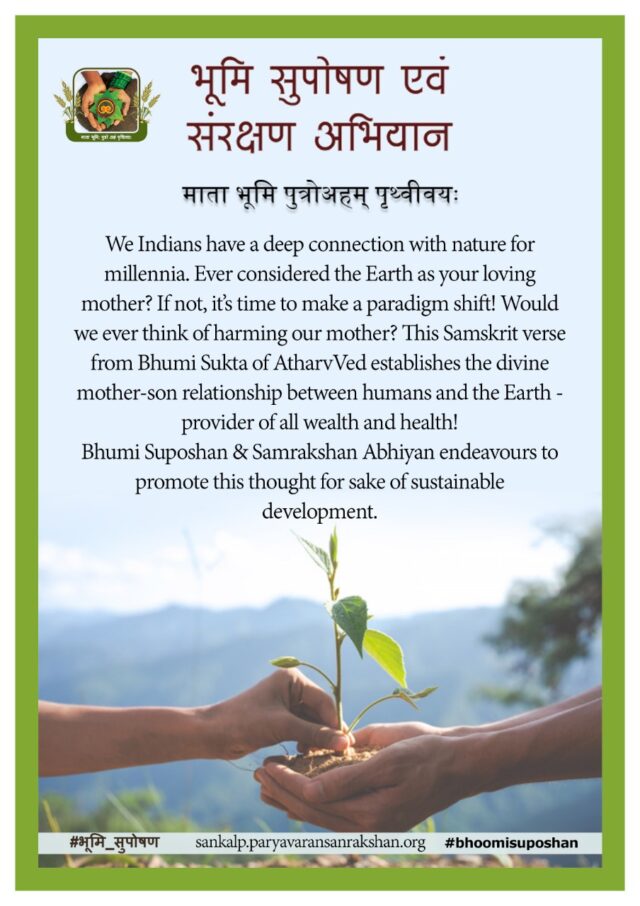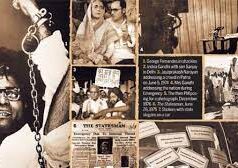
What are we made of? We have learnt in school that living beings are made of the five components of earth, water, fire, air and ether. Ancient Indians described and worshipped them as Panchmahabhutas-the five great forces-Pruthvi, Aap, Tej, Vayu and Aakash. Indian culture has always believed that humans are an integral part of, and spiritually connected to, all the living and non-living entities in the universe.
India’s Vedic civilization has always revered the Earth as Vasundhara or Bhumata – the mother, nurturer and provider of all wealth – with a relationship of love and care as its hallmark. Bhumi Sukt of Atharv Ved says, ‘माता भूमि पुत्रो अहम् पृथिव्याः’, which means the land is our mother and we are her children. Would we ever think of harming our mother? The Rushi (sage) scientists of yesteryears had identified the importance of sustainable use of resources and advocated the same in their teachings.
In the production oriented modern agriculture, NPK are supplied to the plants as fertilizers to hasten the plant growth. Broad spectrum pesticides – insecticides, fungicides, weedicides – are applied in the modern agriculture to wipe out the crop pests and diseases to maximize the crop production.
Regular long-term application of broad-spectrum pesticides, synthetic fertilizers and irrigation are detrimental to the soil microorganisms. Synthetic fertilizers and pesticides ultimately end up in the surface water bodies like streams, rivers and ground water. In brief, synthetic fertilizers and pesticides are responsible for,
- Concentration of carcinogenic substance in the soil due to regular application of broad-spectrum pesticides,
- contamination of ground water due to excess application of synthetic fertilizers and pesticides
- soil becomes hard and compact thus reducing water percolation and water holding capacity.
It is a time to make a paradigm shift! All that is modern need not be sustainable, which is very evident from the ecological degradation seen everywhere, leading to social and medical problems. The agriculture sector is a glaring example. This is where the National Bhumi Suposhan Jan Abhiyan – a flagship campaign initiated to rejuvenate Indian soils – comes into picture with its objective of
reinstating the holistic way of farming that ensures that our fields, rivers and skies remain clean.
Land is not a mere resource
In the colonial regime, whose very basis was conquest and plunder, the loot of natural resources was on the expected lines. Forests, organic farming, localized economies, holistic education and sustainable lifestyles, all were almost completely lost. To the colonizers, land was just an economic resource to be exploited for maximum profits. Damaging the land and water is like attacking our very raw material. If we harm the forces that make us, they have the capacity to break us!
In contrast, ancient cultures had a deep connection with nature for millennia. In Bhartiya Sanskriti (Indian culture), people have believed and practiced since the earliest Vedic times, that the resources provided by Mother Earth are meant for Dohan (sustainable utilization), and not for Shoshan (exploitation). This is the basic difference between the modern and traditional outlook towards development. Indians have always believed in coexistence and harmony with nature. With its right combination of material and spiritual pursuits, India was the prosperous world leader.
Bhartiya Chintan (Indian Thought) on agriculture suggests that farming is not just an income generation activity; but a noble profession that provides healthy food to humanity. This is agri ‘culture’ in the true sense! It is strongly rooted in the local ecology and natural resources. It insists on self-reliance as well as interdependence.
Indigenous research & practices
Indian agriculture (Bhartiya Krishi) returns to the soil whatever is extracted ensuring that least harm is caused to the ecology and resources. The ancient knowledge was based on research and documentation. For instance, Krushi Parashar – a treatise on farming and food production – is a compilation of eternal sustainable practices, which are still valid. Vrikshayurved, which is the
Ayurved for trees and crops, has tremendous potential to revitalize Indian agriculture. This knowledge should be an integral part of contemporary agricultural research in India.
Over the centuries, several generations of farmers, who are not only cultivators but also innovators and indigenous scientists have prepared several thousand crop varieties and animal breeds suitable to the local climate. Bhartiya Krishi Sanskriti is a union of the practical and time tested knowledge of farmers and systematic documentation of the knowledge by the wise men, women and sages in the form of treatises, suktas etc.
In various parts of India, agricultural land is worshipped at a particular time every year to express gratitude. In some parts, the land is allowed to rest and rejuvenate after cultivation. Celebrations such as Raja Parabo in northern Odisha and Jharkhand signify this spirit of sustainability. Different crop varieties are traditionally grown in different parts, depending upon the climate, water availability and soil conditions. Cattle grazing was traditionally undertaken under supervision on designated pastoral lands to avoid overgrazing in forests. All this enables Bhumi Suposhan, which can be translated as soil enrichment.
Problems of ‘modern’ agriculture
During the colonial era, India was forced to follow the European mindset. Post- independence, like many other countries, India continued the ‘modern’ way of farming, partially to overcome the acute food shortage and partly due to the excessive faith in Western solutions, while ignoring the indigenous time-tested knowledge.
Modern chemical agriculture, introduced in the 1960s, is based on the trio of seeds-fertilizer- irrigation. Although termed as progressive, it proved to be destructive in the long-term. Few selected high yielding varieties of wheat and rice were used for enhancing India’s food production backed up with chemical fertilizers, pesticides and assured irrigation. While, the initiative quadrupled the cereal production, thereby transforming India’s fertile areas into ‘granaries’, it was at the expense of regional crop diversity, ecology and health.
Intensive extractive cultivation, with high water demand, is the soul of modern agriculture. It depends on external inputs such as synthetic fertilizers to manage soil fertility, agrochemicals for pest control, expensive farm equipment for deep tillage, fossil fuels or electricity for pumping water and proprietary seeds of high yielding varieties. It gives blanket recommendations for all geographies
and is solely commercially driven, without taking into account local conditions. This leads to soil degradation and severe harm to the ecosystem in the following ways.
- No rest to the soil
- Hardening of the soil, making it impervious
- Decline in soil nutrients and fertility
- Decrease or stagnation in crop production
- Decline in the taste and aroma of produce
- Harm to biological diversity, including micro flora and fauna in the soil
- Pollution of land and ground water
Startling statistics
Under the present method of farming, every year there is a net deficit of about 10 million tonnes in the nutrients added and extracted from Indian soil. Thus, the land is facing a negative balance of nutrients. Agriculture productivity has also stagnated. The 29th report of the Parliamentary Standing Committee on agriculture states that the decadal growth has decreased from 8.4% in 1960-70 to 2.61% in 2000-2010.
A report by National Academy of Agricultural Sciences, states that over 120 million hectares of land in India suffers from degradation. Studies have shown that the annual soil loss rate in India is about 15.35 tonnes per hectare. Excessive use of chemicals is commonplace. For instance, the consumption ratio of nitrogen, phosphorus and potassium (NPK) is 6.7:2.4:1, as against the desirable ratio of 4:2:1. In Punjab and Haryana it is as high as 30:8:1.
High external inputs lead to rising costs, which combined with declining productivity, takes a heavy toll on the socio-economic situation of farmers, with far reaching consequences including indebtedness, suicides, forced urban migration and lack of interest in farming among rural youth. Thus, an erstwhile sustainable economy as well as the ecosystem is ruined. Moreover, there is prevalence of new diseases from eating chemically grown food and drinking poisoned ground water.
Agriculture is at cross roads and it is high time that we revisit our traditional agricultural wisdom – Bhartiya Krishi Chintan. In the shadow of the uncertainty of impacts of the climate change, the world is waking up to the holistic and sustainable agriculture, which ensures cultivation without depleting the soil quality. To our advantage, Bhartiya Krishi Chintan is fundamentally holistic and provides means and ways of sustainable agriculture. Therefore, the choice for the future is obvious. National Bhumi Suposhan Jan Abhiyan endeavours course correction in the present situation for a better tomorrow.
Bhumi Suposhan – The way forward
Wholesome food and clean drinking water free from harmful chemicals are the basic rights of all. Farmlands naturally rich in nutrients, unpolluted rivers and lakes and rich forests are also important for the long-term wellbeing of humanity.
Feed Soil to feed the nation – The Abhiyan envisages enriching the soil by combining the relevant traditional and contemporary inputs. The basis of the Abhiyan is ‘feed the soil to feed the nation. It is essential to revive faith in traditional farming wisdom. This can be achieved by exploring the underlying science. The Abhiyan will work towards promoting appropriate eco-friendly techniques for improving soil health and productivity, which are directly related to the availability of humus and microbial diversity.
Panchgavya – Towards this end, application of Panchgavya (dung, urine, milk, curd and ghee) of Indian cattle breeds is known to be very useful. Cow dung and urine, used along with jaggery, gram flour, lime, farm waste and vermi-compost greatly enhances the soil. Preparations such as Jeevamrut, Ghan Jeevamrut and Samadhi Khad are advised by experts. Thus, cow protection and
conservation of the remaining indigenous breeds of cattle is of paramount importance. Traditional practices such as appropriate crop rotation, mixed cropping, multi-cropping, intercropping, mulching and tree planting on farm bunds are crucial.
Water for all – Management of surface and ground water is an integral component of Bhumi Suposhan. Revitalization of traditional water storage practices, village and farm level water budgeting, integrated water management program treating the entire watershed are some of the means to achieve judicious use of water in agriculture.
Appropriate mechanization – Mechanization is a factor that too needs to be looked at judiciously. The overall mechanization in Indian agriculture is just 40–45%. Its direction has not been suitable for small and marginal farmers, with the focus on tractors. There has been a neglect and decline in the use of Draught Animal Power (DAP), which is an eco-friendly and affordable resource in farming and transport. Combining relevant mechanization with efficient use of animals and manpower is the way forward. Indigenous bullock varieties are sturdy and suitable for Indian climate.
Seed Atmanirbhar Kisan – Developing self-reliance, particularly in seeds, manure and natural pesticides is important. In this era of technology, self-reliance can also be achieved in weather monitoring at the village level. In Bhartiya Krishi Chintan, seeds are not just raw material; but a social, cultural and natural heritage. Farmers should continue to be the natural custodians of Plant Genetic Resources (PGR).
Why the National level Jan Abhiyan?
The aim of the abhiyan is to change the narrative, from mere production-oriented agriculture with huge environmental, cultural and social costs to holistic, sustainable agriculture based on Bhartiya Krishi Chintan which at present merely focuses on increasing the production.
The Abhiyan’s direction will be guided by the following –
‘Feed soil to feed nation’ – Bhumi Suposhan ultimately aims at developing a healthy nation because Suposhit Bhumi, rich in nutrients, provides wholesome healthy food.
An initiative such as Apna Parisar Apni Pehchan (Our environment, our identity) in villages and cities will go a long way in establishing a connect with the land.
The aim is to revive the Bhartiya Krishi Chintan and practices that ensure sustainability.
The Abhiyan is not just an awareness program; but a determined course correction, through continuous involvement of stakeholders including scientists, thought leaders, spiritual gurus, farmers, artisans and the general public, because Bhumi Suposhan is the responsibility of all. For achieving the desired results, training of human resource is crucial.
The 21st century belongs to India. Sustainable agriculture is a prominent area where India can play a leadership role. With our holistic farming practices and naturally endowed land, the sky is the limit for Bhumi Suposhan. Let us join hands to restore the glory of agriculture, which was once considered to be the best occupation!
Courtesy : VSK BHARATH














